INTRODUCTION
Eyelids—Early Signs of Aging
Often in their 40s, but sometimes much earlier, many men and women complain that they “always look tired.” This is frequently an inherited condition. They recognize the same problem in their mother or father. The sign of facial aging usually start with the eyelids. The skin relaxes, the fat bulges forward, wrinkles develop, and a crease forms along the orbital rim, defining it and demarcating it from the cheek. The curved depression that runs from the inner corner of the eye down onto the cheek, just where a tear would travel, is aptly named the tear trough. The demarcation between the lower lid and cheek, called the “lid-cheek junction” is not to be found on models. In youth, the lower lid blends imperceptibly into the cheek.
Eyelid Rejuvenation: Cosmetic and Functional
Patients usually come in with cosmetic concerns—looking tired—and are pleased to learn that there may be functional benefits too. Extra skin may weight down the upper lid, causing an uncomfortable feeling of heaviness. This skin fold can interfere with makeup application. Older patients may find that the extra skin fold of the upper lid is starting to restrict their vision. They find themselves subconsciously lifting their eyebrows not only to see, but to appear to be awake! They don’t want to give the impression that they are not alert, which is obviously socially undesirable. Some of my patients have told me that looking tired all the time seems to make them feel tired too.
Fortunately, this condition is very treatable, and surgery can produce dramatic results. In fact, eyelid surgery is one of the most gratifying procedures for both the patient and the surgeon. The upper lids may be treated alone or in combination with the lower lids. The lower lids may be treated alone, but usually all four eyelids are treated at the same time.
Wrinkle Treatment
Laser resurfacing may be used simultaneously to treat wrinkles around the eyes, crow’s feet, and over the bridge of the nose. Eyelid surgery on its own does not treat crow’s feet because these lines extend off to the side, beyond the end of the eyelid incisions, which are used to tighten the skin. Often Botox injections are used to soften crow’s feet by relaxing the underlying muscles that compress the skin and form the wrinkles in the first place.
Saggy Eyebrows Require a Brow Lift
Some degree of overhang of the brow and upper lid, called hooding, may persist in patients with droopy eyebrows. It is important to recognize that a drop in the position of the eyebrow is often part of the problem of hooding of the upper lid. A simultaneous endoscopic forehead lift (synonymous with endoscopic brow lift) is often recommended to treat this eyebrow descent. Caution is needed when this procedure is combined with upper eyelid surgery to avoid incomplete eyelid closure, which can cause dry eyes.
It is important that the surgeon is trained and has the capability to perform an endoscopic forehead lift because this is frequently the procedure that is needed, not removal of more eyelid skin. If the operator is not a plastic surgeon, it is possible that he or she may not perform endoscopic forehead lifts. Patients need to know that if the operator does not have the capability of doing a procedure, it will not be offered.
PHOTOS OF FEMALE PATIENTS UNDER 50
Epicanthal Fold Correction
S.S., Age 29
Procedure: Upper and lower blepharoplasties.

Before, 6 months after
Dark Circles
R.M., Age 30
Procedure: Lower blepharoplasties, fat injection of the tear troughs (5 cc), and periorbital (around the eyes) CO2 laser resurfacing.
Before, 4 months after
DI 33.
Procedure: Lower transconjunctival blepharoplasties, facial fat injection, periorbital laser resurfacing, and excision on nasal skin lesion.

6 weeks
L.M., Age 35
Procedure: Upper and lower blepharoplasties
Before, 2 months after

L.M., 3½ years after (with makeup)
A.R., Age 41
Procedure: Upper and lower blepharoplasties
3 months
S.S., Age 38
Procedure: Upper and lower transconjunctival blepharoplasties, release of epicanthal folds, erbium laser resurfacing, excision of skin lesions of right upper eyelid and right infraorbital rim.
Before, 5 months after

7½ months after (with makeup)
Tear Trough Correction
C.M., Age 40
Procedure: Upper and lower blepharoplasties and facial fat injection (26 cc). Second procedure, 6 weeks later: CO2 and erbium laser resurfacing.
Before, 10 months after
T.A., Age 42
Procedure: Lower blepharoplasties, facial fat injection (27 cc), and periorbital CO2 laser resurfacing
Before, 1 year after
J.L., Age 46
Procedure: First Procedure: Fat injection of lower face (13 cc) and perioral (around the mouth) CO2 laser resurfacing. Second procedure, 15 months later: upper and lower blepharoplasties, facial fat injection (41 cc), excision of forehead skin lesion, full face CO2 laser resurfacing, Botox Cosmetic injection of forehead and crow’s feet.

Before, 3 months after 2nd procedure.
S.Y., Age 49
Procedure: Upper and lower blepharoplasties, Botox injection of forehead and crow’s feet.

Before, 2 months after
PHOTOS OF FEMALE PATIENTS OVER 50
D.C., Age 58
Procedure: Upper blepharoplasties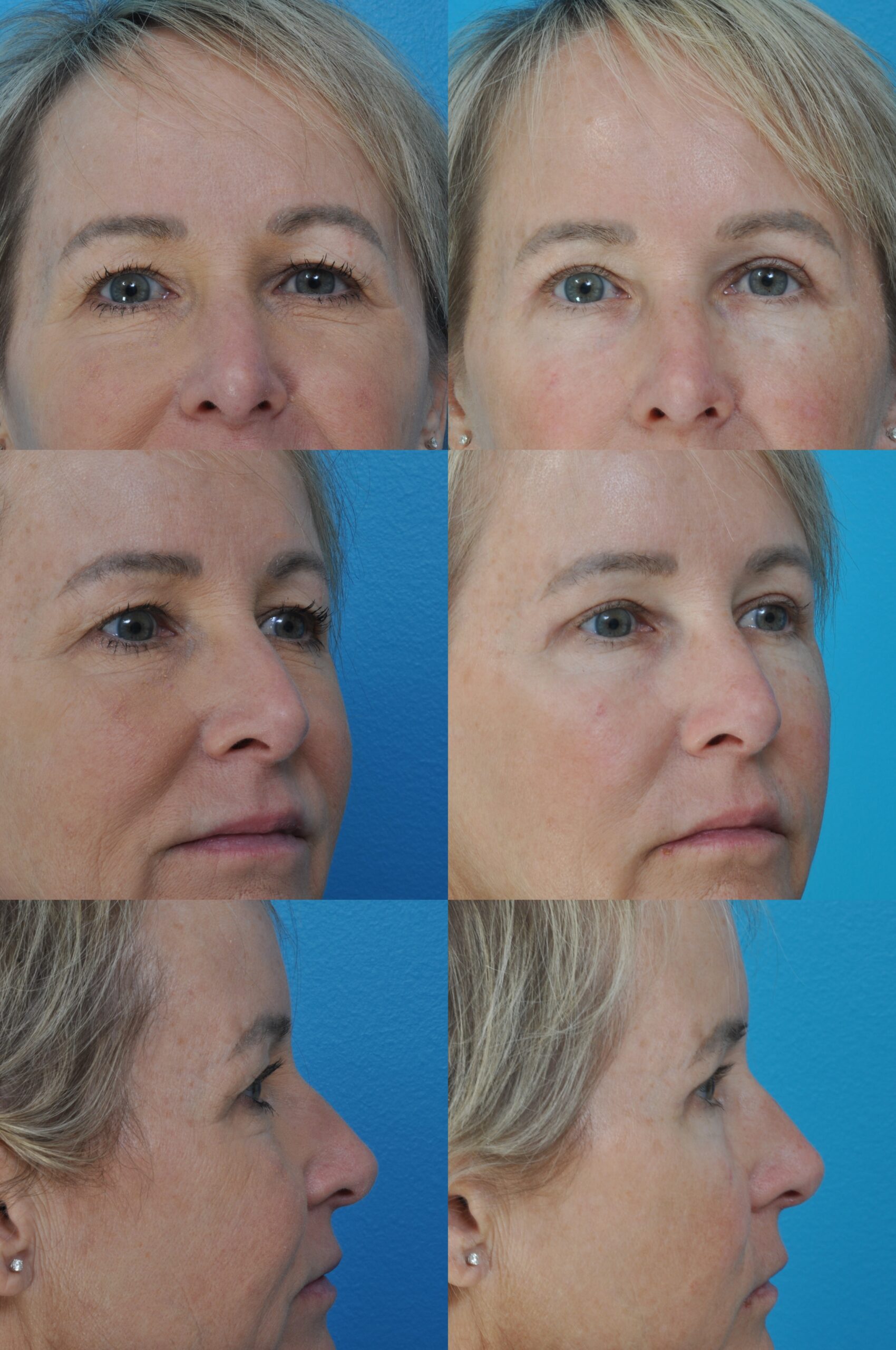
Before, 3 months after
Full Facial Rejuvenation
D.B., Age 51
Procedure: Upper and lower blepharoplasties, facelift, submental lipectomy, fat injection (18 cc), tip rhinoplasty, endoscopic forehead lift, and CO2 laser resurfacing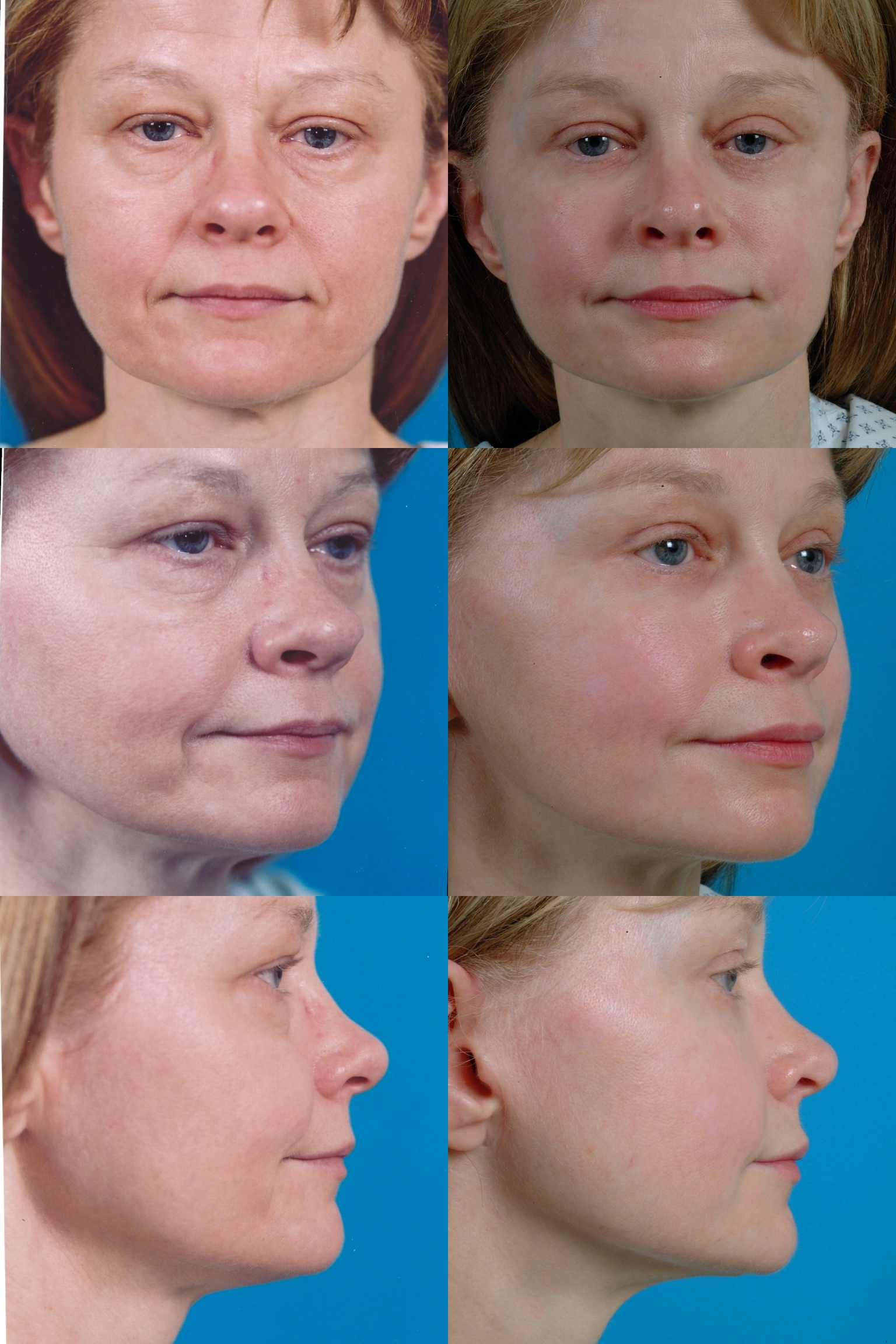
Before, 1½ years after
Y.M., Age 52
Procedure: Upper and lower blepharoplasties, excision of skin lesions. Second procedure, 8 months later: periorbital CO2 laser resurfacing.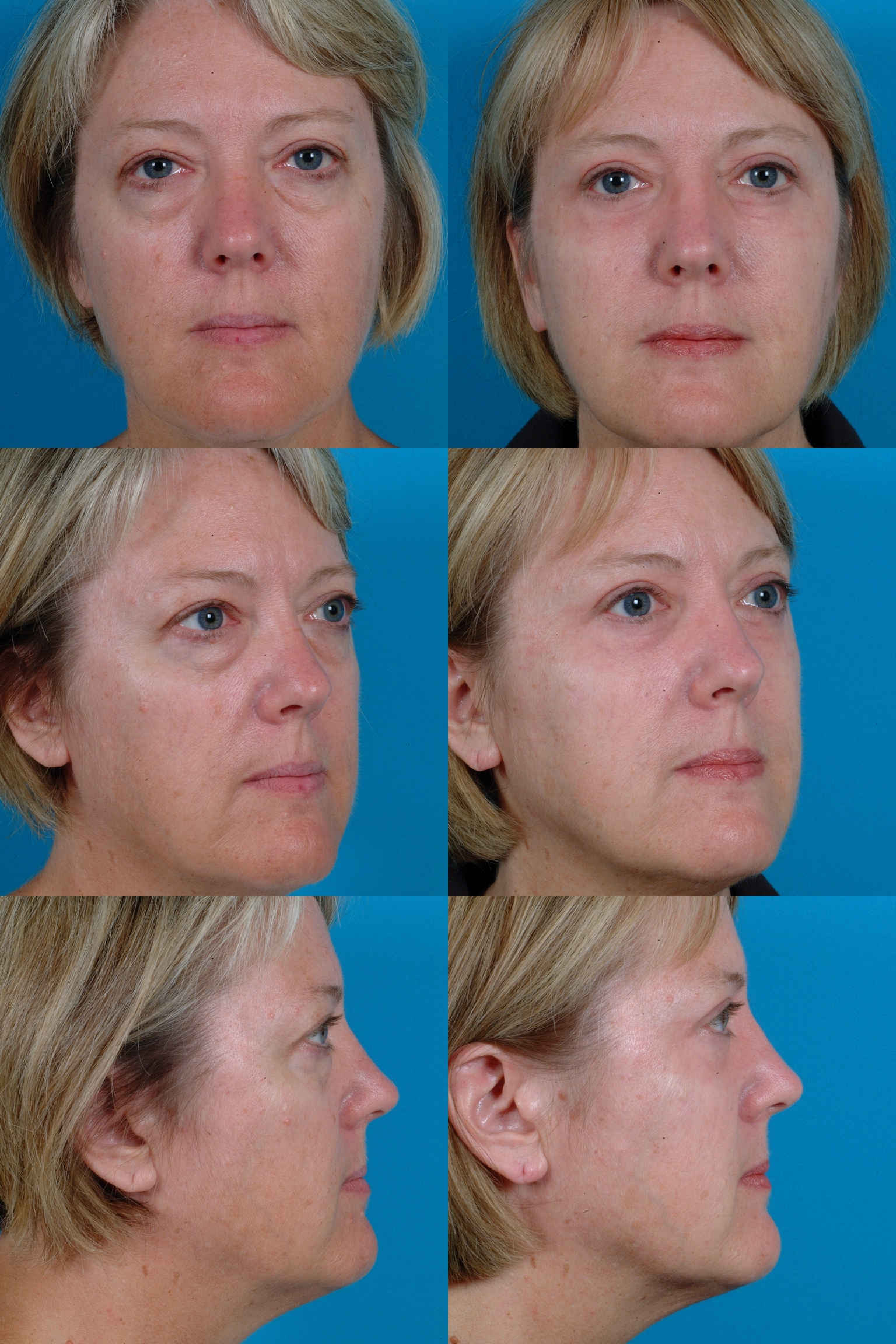
Before, 9 months after (1 month after 2nd procedure).
PHOTOS OF MALE PATIENTS
K.O, Age 39
Procedure: Upper and lower blepharoplasties, submental lipectomy, erbium laser treatment of brown spot on right cheek.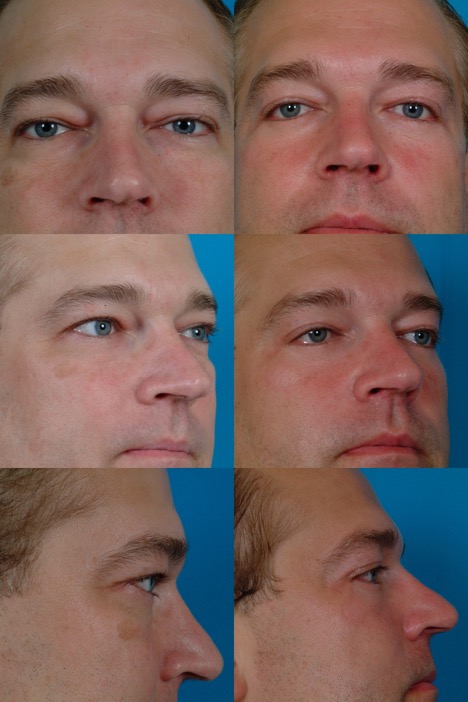
Before, 6 months after
J.C., Age 45
Procedure: Upper and lower blepharoplasties
Before, 2 months after
R.M., Age 60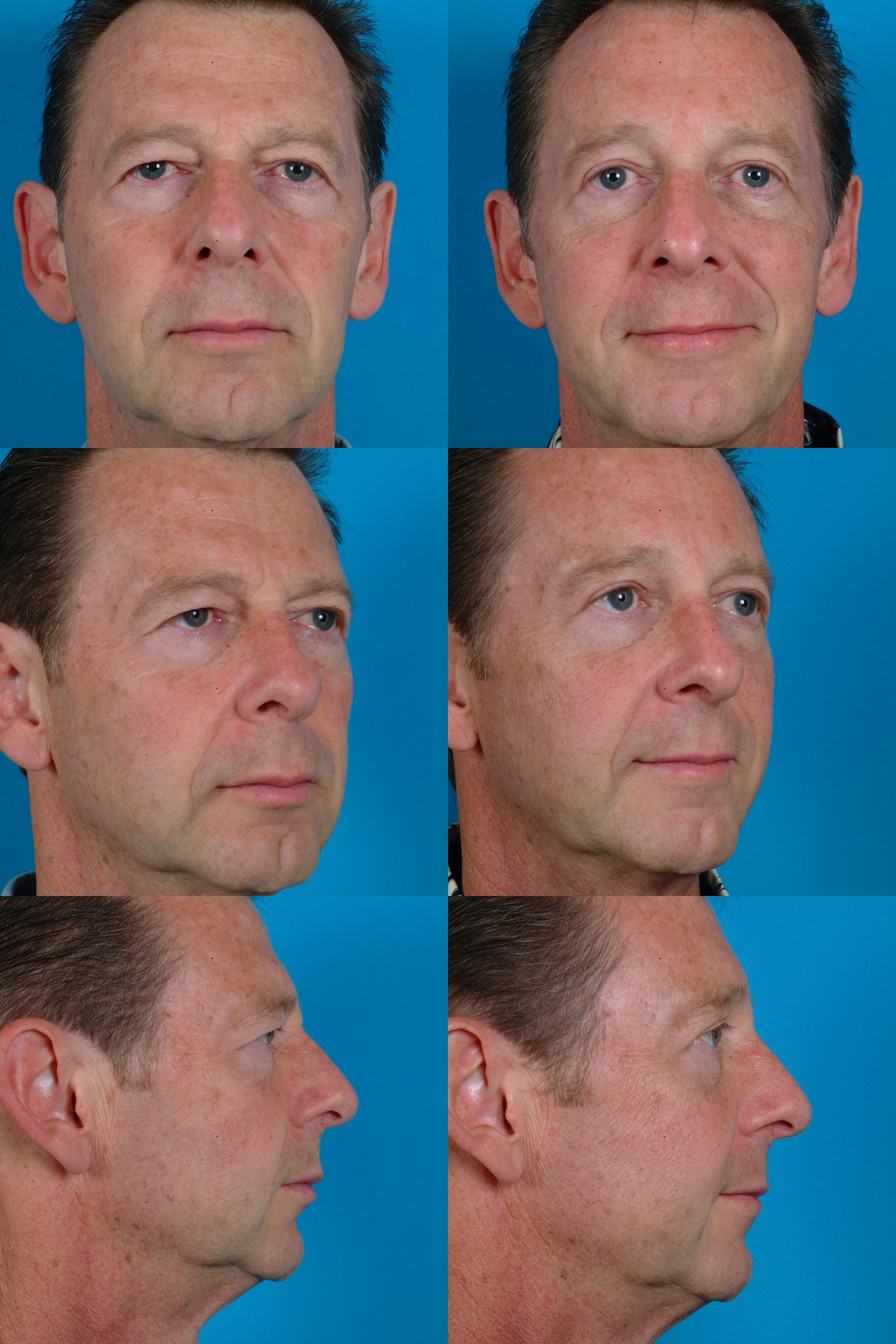
1 Month After
Avoiding Overtreatment
Tissue Preservation
Fat Injection for Tear Troughs
Anesthesia
Laser Treatment of Wrinkles
Incisions
Selection of Internal vs. External Incision
Dark Circles
Laser Resurfacing Adds to Recovery
Lubricating the Eyes During Recovery
Healing after Eyelid Surgery
Swelling
Normal Temporary Findings after Eyelid Surgery:
Ectropion.
Excess Scleral Show and Lid Shortening
Incomplete Eyelid Closure (Lagophthalmos)
Corneal Injury
Blindness
Scarring
Infection
Double Vision
CARE AFTER SURGERY
Getting Back to Normal
• You will experience a variable degree of swelling and bruising of your eyelids. Your eyelids may be swollen halfway shut or even completely closed the morning after surgery.
• Because of swelling, your eyelids may not close completely for several days. During this time, it is vital to keep the corneas from drying out. Keep the eyes well lubricated with artificial tears during the day and ophthalmic ointment at night. Dryness of the corneas can cause serious problems and is best avoided.
• Elevation is most useful to reduce swelling. If the head is kept higher than the rest of the body, there is less pressure and swelling will go down faster. Sleep in a recliner or in a bed with several pillows for the first few nights. After that, elevation becomes less important and you should just sleep normally again. Avoid sleeping on your side for the first few nights, because this might cause the eyelids to swell more on the side next to the mattress.
• Ice packs or cold packs with a protective layer of a soft washcloth next to the skin can help to reduce swelling when applied during the first 24 hours after surgery. These can be applied intermittently (for example, 20 minutes on, 20 minutes off) but it’s also important to get some sleep, so don’t try to follow this timetable exactly.
• Don’t worry about the white part of the eye turning red. This does not mean there has been trauma to the eye itself. It simply represents blood which has tracked around from the eyelid incision, and is now exposed under the transparent “skin” of the eye itself. It will gradually be absorbed over the next few weeks.
• The transparent lining tissues of the eye may swell producing a bubble (chemosis), but this will gradually resolve on its own. It’s a nuisance, but it’s temporary.
• Blood-tinged drainage from the incisions is normal. This is just tissue fluid that has escaped through the incision. As the skin heals, this oozing gradually stops on its own. It is nothing to worry about. In fact, any escaped fluid means there is less for the body to absorb.
• Tearing is normal because the eyelids are swollen and their tear-collecting mechanism is temporarily impaired, so tears, which are produced by the lacrimal gland in the upper orbit, start going over the edge of the lower eyelid like water over a dam. The lower lid has a small hole (lacrimal punctum) that collects tear fluid. It acts like the skimmer of a swimming pool. This elegant tear film system does not work properly because of eyelid swelling after surgery. As the swelling goes down, the lower eyelid collecting tube starts working again. Tearing also occurs when the eye is drier from tear evaporation and the lacrimal gland may be over-stimulated. This problem responds to the administration of drops or lubricant to keep the eye from getting dry. Don’t take an antihistamine or decongestant to try to stop the tearing. Tearing is a nuisance but it’s preferable to dry eyes.
• The upper eyelid suture is a single thread that comes out 3 to 5 days after surgery by simply pulling on one end. The lower eyelid suture either dissolves on the inside of the eyelid if a transconjunctival approach is used, or is removed by pulling on one end, similar to the upper lid suture. After the sutures are removed, the eyelid skin relaxes, the eyelids feel better, and it is usually easier to completely close the eyelids. The small semi-transparent tapes may come off on their own, or they are removed when the stitches come out in the office. They are simply there to hold down the ends of the sutures, so they don’t tickle, and do not need to be replaced if they come off.
• You may shower on the morning after surgery. Be sure to use an antibiotic ointment along the incisions to help to keep the wounds from drying out. Keep any crusts loose so they will come off easily on their own when bathing. Do not try to remove crusts. Let them come off on their own.
• It takes about 2 months for the scars to flatten out. At first, they feel thickened but they gradually soften. Any irregularities from gathering of the skin gradually smooth out. Small puckers at the wound ends, called dog ears, form when excess skin is removed because there is a small area of heaped up skin at the end of the incision. Dog ears may be avoided by making the scar longer, but who wants a longer scar? It is better to keep the scar shorter and accept this dimple that will gradually flatten. Persistent dog ears may be easily revised under local anesthesia at a later time.
• Blurring of eyesight is normal and is usually due to a temporary change in the shape of the cornea. Swelling and traction on the tissues or excessive use of the ointment also contribute to blurring. Use drops are during the day and ointment at night. Blurring takes care of itself as the swelling resolves.
• Itching and redness are normal but the development of “sleep” in the eye may be a sign of infection. Topical antibiotics are prescribed if this occurs.
Q: Is the surgery painful?
A: Eyelid surgery is typically not painful. Patients are uncomfortable because of the swelling and blurry vision, caused by the ointment and temporary swelling of the conjunctiva.
Q: How long do I need to be off work?
A: Time off work largely depends on the importance of your appearance at work. It can take several days for your vision to return to normal because of swelling that affects the transparent eye lining (conjunctiva). Bruising and swelling typically take about 10 days to subside. For most patients, 10 days off work is reasonable, but it is certainly possible to return sooner if swelling and some degree of bruising are tolerable in the workplace. Eyeglasses can help camouflage the area. Most patients are out running errands wearing dark wraparound sunglasses to conceal swelling and bruising as early as a few days after surgery.
Q: How long do the results last?
A: It usually takes decades for the skin to relax enough to need to be trimmed again. It is not unusual for a patient to need a forehead lift rather than a repeat upper blepharoplasty. A repeat upper blepharoplasty has to be done very cautiously to avoid over-resection and the possibility of incomplete eyelid closure (lagophthalmos).
Fat bulges of the lower lids are caused by weakness of the orbital septum, which is a sort of retaining wall that holds the fat back under the eyeball. These bulges take a long time to recur. It is unusual for me to have to redo fat resection and it is important not to remove too much fat, because this can give a hollowed-out look, which is not youthful.
Q: Will this surgery take away the dark circles under my eyes?
A: Dark circles are notoriously resistant to treatment. Makeup helps conceal the dark discoloration. Lower blepharoplasties to remove extra fat under the eyes can help to de-emphasize the circles, making them less noticeable. I often recommend simultaneous laser resurfacing and fat injection. The fat is placed in the tear troughs to reduce the demarcation of the lower lids. Laser resurfacing can provide some lightening. Youthful lids blend into the cheek without a noticeable trough or border. These treatments work together to soften and smooth the lid-cheek transition, a hallmark of aging.
Q: Can this surgery be done if I’m having Lasik surgery for my vision?
A: Yes. We usually allow a few weeks between procedures for healing and resolution of swelling.
Q: How bruised and swollen will I be? How long does this last?
A: Swelling and bruising vary greatly from patient to patient. Bruising goes away before the swelling fully resolves. In most patients, the bruising clears in about 10 days. Almost everyone is back to work at this time and some return much sooner. It takes a few months for the eyelid swelling to completely subside.
Q: Will I be able to see properly after surgery?
A: Your vision may be blurry at first because of the swelling that also affects the cornea, making it difficult to read after surgery. The eye lubricant also makes your vision blurry.
Q: Will my eyes appear “bloodshot” after the surgery?
A: There is often some redness of the white part of the eye (subconjunctival hematoma) that can look scary, but is not dangerous and goes away on its own. It is simply blood that has tracked across the eye from the eyelids and is absorbed.
Q: I once heard of someone who couldn’t close her eyes after this surgery. Could that happen to me?
A: Yes, but this is likely to be temporary. Most patients cannot completely close their eyes after surgery for at least a few days and sometimes a week or more. It is essential that they use lubricant during this time. It is possible that this problem might persist, although eventually the swelling tends to go down and the tissues loosen to allow eyelid closure. Experienced surgeons are cautious not to remove too much skin.
Q: I know I can’t wear my contacts for 2 weeks after surgery. What about my glasses?
A: Glasses are fine. They will also help to disguise bruises and swelling when you go out. You can wear contacts when the swelling goes down enough so that you can easily manipulate your eyelids. Some patients can do this a week after surgery.
Q: I have to return to work right away. How can I cover the bruises?
A: If you do not have laser resurfacing, you can apply makeup a few days after surgery. There is really no point trying to apply makeup before that time because you are not going to look good anyway. If you have laser resurfacing, you need to wait until the skin has healed, which can take a week or so. Mineral-based makeup works well to hide redness after laser resurfacing, and may also help with UV protection.
Q: Is it okay if I am in the sun.
A: Sun exposure or UV exposure in a tanning bed is not advisable on any healing wound because it can cause hyperpigmentation. This principle is especially true after laser skin resurfacing. You can be outside, but be sure to take precautions: Wear a hat and sunglasses. Always use sunblock after the skin treated by the laser has healed. Before you can use sunblock you simply have to avoid the sun, even when in a car.
